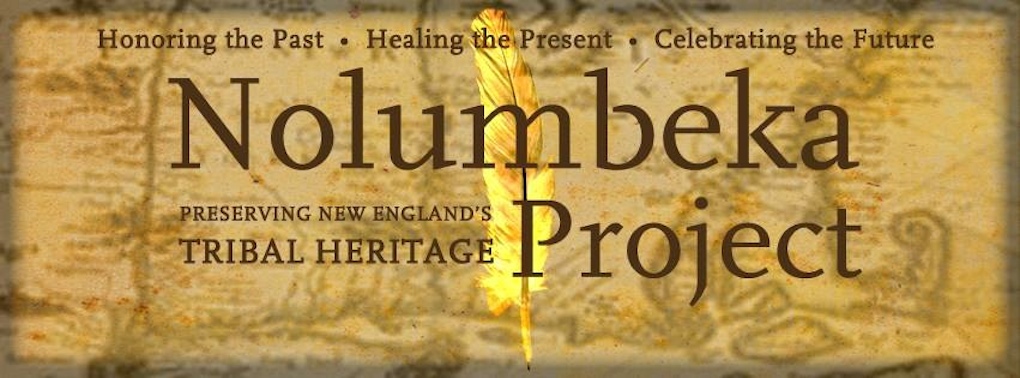The Story of Nolumbeka
Nolumbeka
is an Abenaki word which means “a stretch of quiet water between the
two rapids”. This word likely is the source of the name Norumbega,
used by the early European explorers and appearing on the maps for the
area of present day New England from 1529 to the 1580s. For several
years after that, the area became considered an extension of the
Virginia colony until 1614 when John Smith gave it the name of New
England.
Much
of the story about a City of Gold in eastern North America was based on
reports of English mariner David Ingram who, after being shipwrecked in
the Gulf of Mexico in 1568, walked and paddled canoes over three
thousand miles along distinct and well-marked trails to the northeast in
eleven months. Ingram’s description of Norumbega was narrated about ten
years after he returned to England and was published in 1582.
Ingram’s
statement about his journey, which follows, was taken by Sir Francis
Walsingham, Queen Elizabeth’s Secretary of State in 1582, in response to
questions primarily aimed to gain information which would be useful for
colonization of North America and how it pertained to this interest:
*“Certayne
questions to be demanded of Davy Ingram sayler dwelling at Barkinge in
the countrye of Essex, what be observed in his travel one the North side
of the river of May where he remained three month or thereabouts.” (before returning by ship to Europe).
“He hath confessed that country be frutfull and that there is a tre as he called it a plum ten tree wth
of the leaves thereof being pressed will come a very excellent lycor
as pleasant to drincke and as good as and kinde of winne.”
“He hath confessed, y2 he sawe A Beast in all points like unto a horse savinge he had two longe tusks, of wch he
was put in great danger of his lyfe, but he escaped by clyminge a tree.
Also that there be wyld horses of goodly shape but the people of the
country have not use for them. Ffurther that there be shepe, wch beareth red woole some thinge course there flesh good to eat, but it is very redde.”
“He hath confessed yt farre
into the land there be many people , and that he saw a towne half a
myle longe, and had many streets far broader than any street in London.”
“Ffurther yet, the men gooe naked savinge only the myddell part of them, covered wth skynnes of beasts and wth leaves. And that generallye all men weare about there arms dyvers hoopes of gold and silver wch are of good thickness and lykewyse they weare the lyke about the smale of there legs wch hoopes are garnished wth pearle dyvers of them as bigg as ones thume.”
“That the womenne of the countrye go appareled wth plates of gold over there body much lyke unto an armor about the middest of there bodye they wear leafes, wch hath
growing there one very longe much lyke unto heare, and lykwise about
there armes and the smale of there legs they weare hoopes of gold and
sylver garnyshed wth fayer pearle.”
“He hath confessed y2 thye
buyld there houses round lyke a Dovehouse and hath in like manner a
louer on the topps of there howses and that there be many pillars that
upholdeth many things of gold and silver very massye and lykewyse many
pyllars of Crystall.”
“He hath confessed that there is great aboundances of gold, sylver and
pearles and of other jewells in that country. He hath confesses that
there is a great aboundance of gold, sylver, and pearle and that he hath
seanne at the heads of dyvers springs and in smale rounninge brouks
dyvers peaces of gold soume as bigg as his fynger, others as bigge as
his fyst and peaces of dyvers bignes. Ffurther that he seanne great
aboundance of pearle and dyvers strange stones of what sorte or valewe
we knewe not.”
“He
hath confessed that there be in that country great aboundances of a
kinde of beast almost as bigge agayne as an oxe in shape of body not
much differinge from an oxe, savinge that her hath eares of a great
bignes, that are in fashione much like unto the eares of a bloodhound
having thereon very longe hears, and lykwyse on his breast and other
parts of his bodye longe heare. Ffurther he hath reported of dyvers
kinds of wyld beasts whose skynnes are very rich rich furres, lykwyse of
dyvers kinds of fruts and trees of great eastimatione.”
“That there is a tree wch beareth
a frute lyke an aple but is poison to eate for the aple beinge broken
there is a blacke lycor in the mydest thereof. Also that there is a tree
that the barke thereof tasteth lyke pepper.”
*(from
“Simon Ferdinando and John Walker in Maine, 1579-1580”, by the Rev. B.
F. DeCosta, D.D., New York City, excerpted from the New England
Historical and Genealogical Register, Volume 44, April 1890, pages
151-153)
This
information was gleaned from the over 50,000 pages of research compiled
by Howard Clark to be archived by the Nolumbeka Project. Digitizing this archive is underway with the
the financial support of the Community Foundation of
Massachusetts, Credit Data Services Inc. Fund, and the Board
Discretionary Grantmaking Fund.
